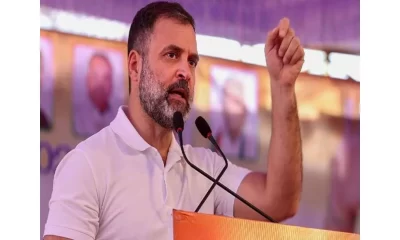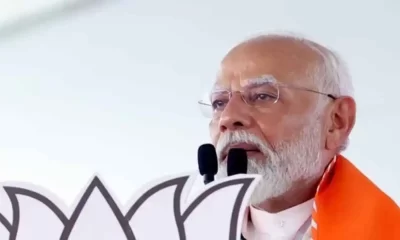Latest Art & Culture
“Heritage is not just something which is 100 years old”
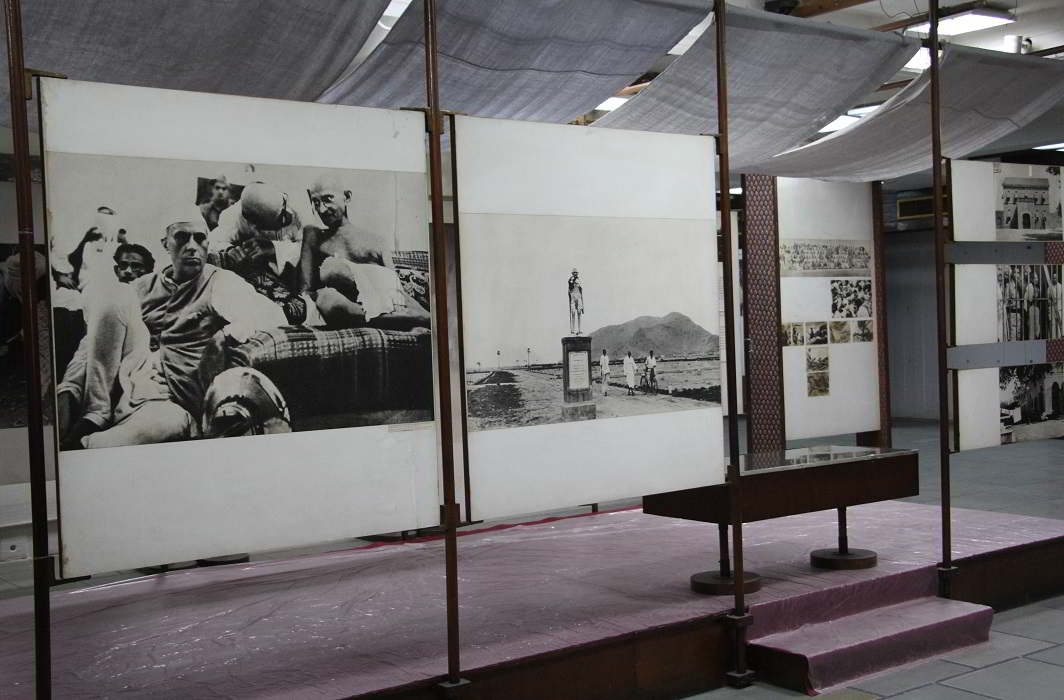
[vc_row][vc_column][vc_column_text]The India Trade Promotion Organisation proposes to demolish iconic structures at Pragati Maidan—Hall of Nations, Hall of Industries and Nehru Pavilion—and in their place, much to the horror of Indian architects and heritage conservationists, construct a state-of-the-art convention centre, a hotel and a parking lot. The Indian National Trust for Art and Cultural Heritage (Intach) has filed a plea in court against it. Dr Swapna Liddle, convenor of Intach’s Delhi Chapter, spoke to Shailaja Paramathma. Excerpts from the interview:
Why are the demolitions proposed, who proposed them and when are they to take place?
The proposal has been on for a while but I won’t be able to tell you exactly when the proposal to redevelop Pragati Maidan in such a comprehensive manner came. These things are decided at governmental level and we oversee the other end of the issue. We heard about it when it came out in the press. Preservation of “modern heritage” has been gaining increasing international recognition and that is of concern to us here. We must understand that it’s not just antiquity that needs to be preserved, particularly since we live in such fast-changing times. If you look at the buildings constructed immediately after Independence, like the Supreme Court, the National Museum, Krishi Bhawan, Shastri Bhawan, those buildings still have a little bit of the Lutyens style of architecture. Hall of Nations, on the other hand, was a modern structure. It is also from the post-Independence era but from a time when the nation was coming into its own, it was shedding the colonial legacy, seeing not only its individuality but also its vision as a modern progressive nation. It was an important moment in our architectural history and also in our history as a nation.
The Indian Express on January 25 said: “Intach, in its plea, has alleged ‘complete abdication’ of responsibility by Heritage Conservation Committee (HCC) and Delhi Urban Art Commission (DUAC) to protect the city’s ‘contemporary architectural heritage’.” Has the situation improved since then? Or has Intach rubbed HCC the wrong way by saying this?
We have not just been proactive when it comes to modern heritage; we have been proactive when it came to unprotected monuments. Today, in Delhi a lot of buildings are protected because we took the initiative to list them. We approached the authorities, went to court and that’s how it happened. In 2013, DUAC and HCC said Intach should make a list of modern heritage buildings and also develop criteria for it. Listing is our major job, we made a list of 62 buildings, developed criteria and forwarded to them. They were supposed to have taken it forward but they did not. Even when the proposal to demolish buildings in Pragati Maidan came, they still did nothing. They were not paying the matter the attention it deserves and we wanted them to be forced to look at it. As far as rubbing people the wrong way goes, we do that a lot.
Why does ITPO want to demolish these iconic structures?
We are so obsessed with the words “world class” that we are losing our national identity. ITPO is not even willing to consider a compromise. When we put up this proposal, one of the statements said that we are not asking for strict developmental restrictions but only to not demolish these iconic buildings. Redevelopment plans can be well accommodated alongside the old structures.

The iconic buildings were created by structural engineer Mahendra Raj and architect Raj Rewal in 1972, and are still looked upon as futuristic landmarks more than 40 years on.
In reply to Intach’s remark on abdicating responsibility, the HCC told the court that “the list of 62 buildings, which includes India International Centre, the Jawaharlal Nehru University, Lotus Temple (Bahai House of Worship) and Shri Ram Centre for Performing Arts and Crafts Museum, has no sanctity”. Will this mean more demolitions of architectural marvels in Delhi? What about the sanctity of “world memory”?
You see, the courts are there to protect the buildings which are protected under law. But the HCC has a further responsibility of identifying potential candidates for the protected list. In 2013 they applauded the idea of preparing the list; it’s a very silly thing to say now that it has no sanctity. Of course it has sanctity, what it does not have is legal sanctity and that is where HCC should have come in.
How relevant is the redevelopment proposal to build an international exhibition and convention centre with a seating capacity of 7,000 and parking for 4,800-5,000 cars where these halls stand now?
Pragati Maidan is 123 acres big, so there is a lot of room to accommodate people and for parking cars. But if you are going to do that, you need to know what it is going to mean for the roads and traffic in that area when all those people pour in. We know what happens during the two weeks of the Trade Fair. And if that is happening on a regular basis, is that a desirable thing? Has any feasibility study been done on it? How will the traffic be affected?
If our present convention centres fall below international standards, is it not more judicious to upgrade them instead of razing perfectly good structures and buildings? Why do we not do this?
I think it’s just laziness in thinking creatively. It’s so much easier to work on a clean slate, isn’t it? But this is just a speculation.
How important or necessary is this structure to host the G20 Summit? And will it be ready in time for the G20 in 2018? How high are the possibilities of it going the way the Commonwealth constructions went in terms of corruption and time management?
I don’t have any inside knowledge on this but if that is true, I don’t know how it’s going to work.
The Indian Institute of Architects supports you, 3,000+ people have signed the online petition to save these halls from demolition. The Museum of Modern Art, New York, has sent a letter to the Ministry of Commerce and Industry calling it “the first large-scale spatial structure in concrete in the world.” How much effect has all this had on the decision-makers?
From the beginning, we have taken people along with us. We have had meetings in Intach, there were workshops, we had people who are relevant in this field give talks. They all recognise the significance of the buildings we are trying to preserve but so far all of this has had no impact at all. And because we felt that it was not making an impact, and because both HCC and DUAC knew of all these people’s support and still not doing anything we decided to go to court. Going to court is not an easy thing for anybody to do, especially for an NGO, because of the expense of litigation.
So what happens if the court gives the go-ahead for demolition? What are your plans then?
I think we will wait and see what the court actually says. We have very supportive lawyers who have worked very hard on this. Let’s see what happens.
In an ever-growing city like Delhi with the ever-present space constraints, how feasible is it to hold up acres of land in the name of heritage and how difficult is the job?
If you go through the list of the 62 buildings identified by us, there are buildings like the Vigyan Bhawan, Dak Taar Bhawan, Triveni Kala Sangam. And these are only suggestions. We are asking HCC to examine them, assess them and decide which are relevant to keep and which are not. It’s not written in stone that these will never ever be demolished. Sheila Theatre is also on our list. It is a style of construction from a particular era and it will never be there again and thus it is worth preserving. We are not saying preserve every example of that kind of building, we are saying preserve a few; 62 is not a big number for Delhi. The space argument is often made when you talk of Lutyens’ Delhi. There is a lot of issue on that, should we redevelop, should we make it denser? I think it would be a big mistake because even Lutyens’ Delhi makes up about only 2 percent of the whole of Delhi. And not just that, it is an important green lung for the city. In the middle of the city Lutyens’ Delhi has a large number of trees which is of benefit to all the outlying areas. If you increase the density there, all those roundabouts that exist without a red light, they will become impossible to work. The whole city plan which is based on those roundabouts and the radial roads will cease to function. These are things which should be taken up with a whole amount of thought. The idea that you can build a little more just to get that little bit of extra land, that idea is not worth it. It is a very short-sighted approach.

The design was evolved to meet the constraints of time, availability of materials and labour, but above all, to reflect symbolically and technologically India’s intermediate technology in the 25th year of Independence.
Are there any new provisions under Budget 2017 for heritage conservation and preservation in India?
I have not looked it up.
If we were to compare the visibility of your projects on social media, with, for example, Project Tiger, you would really rank way below. Why do you think you did not manage to sell heritage preservation as the next cool thing? Why is your presence on social media so weak?
We have been so busy trying to do so many things that we have sort of lagged behind here. Something like Project Tiger does not have so many vested interests ranged against the tiger. But look at the kind of stakes that are ranged around real estate in Delhi, for instance. It becomes very difficult for us to explain to people why modern heritage is important. I think we could have done more in educating people on what is so important about modern heritage. There is also a budget constraint, but you can always raise this money. We have been so busy doing the leg-work in producing the documentation, going to HCC, maybe we didn’t do enough of the other stuff.
Are you in touch with the architects who designed and constructed these iconic structures—Raj Rewal and Mahendra Raj? They conceived and constructed these structures in spite of the many challenges they faced. These architects are alive and they are disappointed with the proposed demolition of their work.
I am not personally very much in touch with them but Mr AGK Menon is. He is the founder-member of Intach. Look at it this way, these people should be our national pride. These are architects who are Indian, working in India who have international recognition. The Hall of Nations is an internationally recognised piece of architecture. When you raze it, who is going to come in and design the new structure? Are there any big names in Indian architecture who will design? You are completely sidelining Indian architects who have done a great job. All this national pride we keep talking about is very hollow. I don’t think there is enough recognition for Indian architects and the great job they have done. In my opinion, heritage is something we are making all the time and it’s not just something which is 100 years old. If we do not take care of what was built in the ’70s or ’60s or ’50s just because it’s not old enough then 20 years down, we won’t have any ’70s building.
Is there a political angle to this whole demolition business? These structures are, after all, a legacy of the Nehruvian era. Is one of the reasons for this proposed demolition the fact that the BJP is at the centre?
I don’t know. I think this redevelopment plan pre-dates the BJP’s arrival at the centre. Maybe it gained momentum during this period, but I am not sure. Intach’s credentials are not in doubt as far as government recognition is concerned. I think it’s more about, let’s make this wonderful convention centre and get rid of these inconvenient old structures.

The depth of the structural system was utilised as a sun-breaker and conceived of in terms of the traditional jaali, a geometrical pattern of perforation that serves to obstruct direct rays of the harsh sun while permitting air circulation.
How are things different in Europe? Their architectural heritage is so well-preserved. What do they do that we don’t?
In Europe, modern heritage has caught on as an idea and architects are respected. So those who have done good work, even in the recent past, are recognised and their structures have a certain renown attached to them. They are valued and protected. But we just don’t seem to have that culture. Moreover, there are strict laws and they do not flout them with the kind of impunity we see here. In India, it’s often our government bodies that are the quickest to make exceptions. For example, it is being proposed that laws that govern prohibition or restriction of any construction around an ASI site will be relooked at for government projects. So, when the government wants to build a road or a flyover they make exceptions. When the government itself chooses not to abide by the rules then what will happen to the aam janta?
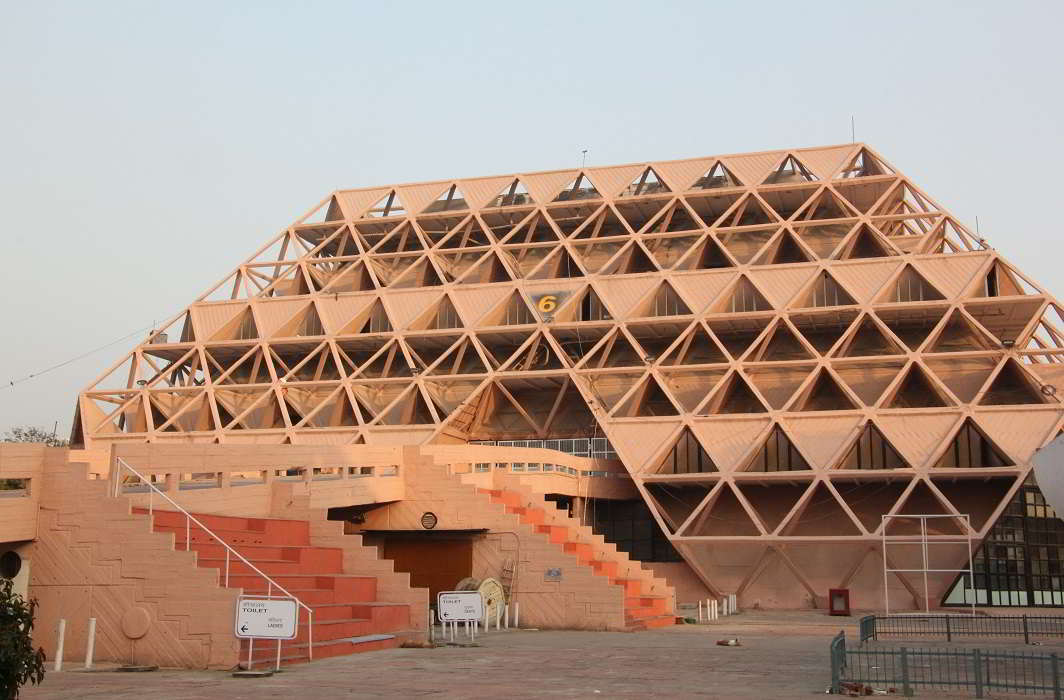
The main pavilion of the Hall of Nations has a clear span of 78 metres and a height varying from three metres to 21 metres, thereby providing a vast capacity for items to be exhibited, from books to bulldozers.
Are the laws that govern conservation and preservation of heritage not strong enough?
Most of our laws are very strong. The problem in India is of implementation, it’s such an uphill task. If you look at Mehrauli Archaeological Park, which is another legal battle that we are fighting, it’s enormously difficult. The authorities have completely failed to prevent encroachments and defacements there. Pragati Maidan is a modern heritage; it’s a much more contested issue but not Mehrauli.
The Intach website says: “It is in the light of the changing attitudes towards architectural heritage, that the Intach Delhi Chapter has taken up the task to have Delhi inscribed in Unesco’s list of World Heritage Cities.” How is this coming along?
Well, that is a story which for the moment is closed. It was an initiative of ours; we wondered how no Indian city was a part of Unesco’s list of world heritage cities. We have some amazing cities, so we did a lot of research on this, we talked to a lot of people, invited all sorts of experts to talk about it, published research papers, held seminars and workshops. We discussed this very thoroughly and we came up with a nomination to be submitted to Unesco which was for Shahjahanabad, the Mughal imperial city, and Lutyens’ city, the British imperial city. We said these are two imperial cities of New Delhi, twin cities; they should be put on Unesco’s list. We did our documentation and prepared a beautiful dossier. The Delhi government had engaged us to do this when Sheila Dikshit was the chief minister. We submitted this to Unesco and they put it on their tentative list, a technical committee came in to inspect the site and then the application was unilaterally withdrawn. Our application was withdrawn; we were not rejected by Unesco. Everything goes through ASI and just when the process was coming to an end it was withdrawn. The state government had done its job, submitted its dossier, but it was then withdrawn by the central government. So that was it. It’s not even like we lost, it’s a no-go. It was very disappointing because we had done the job and we had a reasonable shot at success. We thought it would be great to generate pride in the city. We are hopeful that at some point we will revive it if we can persuade the people and the government.
Photographs by Bhavana Gaur
[/vc_column_text][/vc_column][/vc_row]
Entertainment
Yashraj Mukhate collaborates with Amit Trivedi for Mann Dhaaga song
In a post circulating on Instagram Yashraj Mukhate talks about his experience of listening to Amit Trivedi’s music and recalls how he had always dreamt of collaborating with Amit Trivedi. He said his dream came true 2 years later in 2024 where he collaborated with Trivedi on the song Mann Dhaaga.
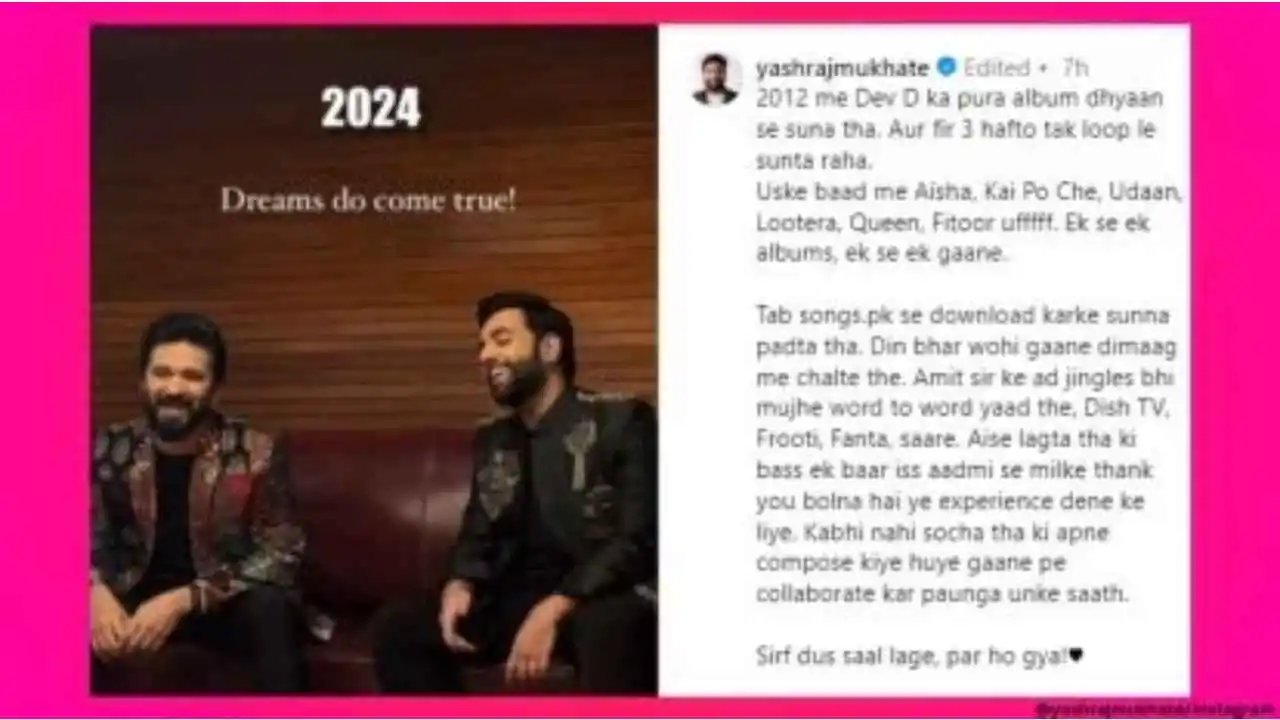
Amit Trivedi is known for his soulful compositions which weave profound lyrics, captivating music lovers. His songs spark a deep desire in aspiring artists to collaborate with him. Music producer and You Tuber Yashraj Mukhate had immense admiration for Trivedi’s artistry. In a post circulating on Instagram Yashraj Mukhate talks about his experience of listening to Amit Trivedi’s music and recalls how he had always dreamt of collaborating with Amit Trivedi.
He said his dream came true 2 years later in 2024 where he collaborated with Trivedi on the song Mann Dhaaga. He wrote that he had been listening to the entire Dev D Album carefully in 2012. And he kept listening to it on loop for 3 weeks. He continued to listen to Amit Trivedi compositions in Aisha, Kai Po Che, Udaan, Lootera, Queen, Fitoor continuously. He said he could not stop himself and became a big fan of the music director. He said he started dreaming of meeting his idol one day and collaborating with him.
He recalled that he had to download songs from songs.pk and listen to them. He said the songs kept running inside his mind all through the day. He added that he even remembered Amit Trivedi’s ad jingles word for Fanta, Frooti, Dish TV and all of them.
Mukhate said he always dreamed of meeting Amit Trivedi and wanted to thank him for giving this experience. The post has gone viral on social media with 96,445 likes till now. Large number of social media user commented on the social media post where one user Parth said the Yashraj Mukhate was truly an inspiration. One user said his dedication had brought him to level. One user said a man should make all his dreams come true by going through one hustle at a time.
Book reviews
The Sattvik Kitchen review: Relook at ancient food practices in modern times
If you are the one looking to embrace healthy food habits without compromising on modern delicacies, then this book is a must read!

The cacophony of bizarre food combinations across the streets of India has almost taken over the concept of healthy food practices. Amid this, yoga guru Dr Hansaji Yogendra’s The Sattvik Kitchen, published by Rupa, is a forthright work that takes you back to ancient food practices and Ayurveda.
As the subtitle reads, The Art and Science of Healthy Living, the book endows a holistic approach to ayurvedic diet along with modern evidence based nutrition. From Basil-Broccoli Soup to Sprouted Green Gram Salad and Strawberry Oats Smoothie to Mixed Dal Parathas, the book not only provides you with the recipes but also stresses on healthy cooking tips together with nutritional benefits.
Besides, Dr Hansaji Yogendra’s book emphasizes on the traditional methods of food preparation and the advantages of using traditional cookwares like iron and copper vessels. The narrative portrays a balanced approach, knitting traditional wisdom with contemporary scientific understanding.
The author, through her book, sheds light on the principles of Ayurveda and highlights the metamorphic potential of adopting ancient food practices. She explains how our body reacts to food in terms of timing, quantity, manner of consumption and seasonal considerations. The book adeptly reintroduces ancient home remedies tailored to address various contemporary health issues.
Dr Yogendra, in her book, decodes the importance of nutritional knowledge to optimize both immediate and long-term health outcomes. It provides deep insights to understanding the intricate relationship between food choices and overall well-being, weaving Ayurveda with practical perception.
The book not only celebrates food philosophy but also offers a practical view into weight loss, well-being, and the profound impact of dietary choices on both physical and emotional aspects of our lives.
If you are the one looking to embrace healthy food habits without compromising on modern delicacies, then this book is a must read! The book is a roadmap to navigate the challenges of the modern day kitchens.
Book reviews
The Deccan Powerplay review: Bashing Chandrababu Naidu and his legacy
Amar Devulapalli’s book The Deccan Powerplay cornersthe TDP strongman with every petty incident exaggerated a la Baahubali

Mike Marqusee’s War Minus The Shooting is a seminal book on cricket and its influence on culture and politics in the Indian sub-continent during the 1996 Cricket World Cup. Amar Devulapalli’s book The Deccan Powerplay, published by Rupa, sounds like a similar exercise with its clear subtitle, “Reddy, Naidu and the Realpolitik of Andhra Pradesh“. The ambitious sounding subtitle crumbles under the weight of belied expectations of a scholarly treatise on the political interplay between the Reddys, the Kammas and the erstwhile united Andhra Pradesh. One can blame it on one’s own hopes and excuse the author of the lapse since the book has just three people to discuss: YS Rajsekhara Reddy, N. Chandrababu Naidu and Y.S. Jagan Mohan Reddy.
The chief protagonists here are YSR and his son, the incumbent Chief Minister of bifurcated Andhra Pradesh, Jagan Mohan Reddy. The lone villain, and one crafty as a fox if ever there was one, is Chandrababu Naidu. The book devotes a chapter to the corruption cases against Naidu, for which he was arrested in September 2023.
In crafting the narrative, the other heavyweights of Telugu country are discussed in passing, as peripheral players. N.T. Rama Rao does get the starring role, as befits the Telugu star of yesteryear and the founder of the Telugu Desam Party. But even this is fleeting. The Congress, which ruled the state till bifurcation, is portrayed as a faction-infested animal — so what if YSR stayed in the party both as loyal soldier as well as a seasoned yet dynamic general?
The book sets out to demolish the halo surrounding Naidu as the man who brought Information Technology majors to Hyderabad, nay Cyberabad, by beating Bengaluru. His breaking with NTR is depicted as a shrewd, calculated gambit to displace the TDP founder, who was also his father-in-law.
The book is replete with this and more Naidu nitpicking. Naidu took no bullshit from politicians or journalists. He gave it back to the scribes when needed, apart from his favourite media groups, one of the reasons they were not very happy kowtowing to him,
as the book suggests. Instead they would make ostentatious bows to any political alternative merely for being less brusque than the now-out-on-bail former CM.
The book picks apart every claim Naidu ever made and portrays him as an opportunist. The problem with this is possibly because Naidu preceded Jagan Mohan as the rump AP’s last CM and had presumably used every trick in his arsenal to discredit the younger contender.
With Assembly elections due this year, this book reads like a party pamphlet and comes across as a political weapon among the undiscerning. An Instagram handle could have been more useful to this end. But for such a grandly-titled book: the anticlimax is swift and painful.
-

 Entertainment23 hours ago
Entertainment23 hours agoDo Aur Do Pyaar social media review: Social media users say Vidya Balan, Pratik Gandhi deliver standout performances in this adorable film
-
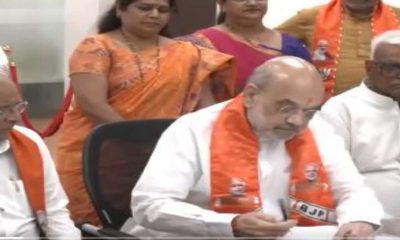
 2024 Lok Sabha Elections24 hours ago
2024 Lok Sabha Elections24 hours agoLok Sabha elections 2024: Amit Shah files nomination from Gandhinagar
-

 2024 Lok Sabha Elections20 hours ago
2024 Lok Sabha Elections20 hours agoDeserted by key supporters, the Kamal Nath story looks set to wind to an end in Chhindwara
-

 Entertainment21 hours ago
Entertainment21 hours agoAditya Roy Kapur, Sara Ali Khan’s Metro In Dino to release this November
-

 2024 Lok Sabha Elections22 hours ago
2024 Lok Sabha Elections22 hours agoLok Sabha Elections 2024: Nearly 40% voter turnout till 1pm
-
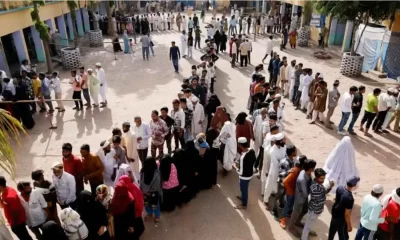
 2024 Lok Sabha Elections18 hours ago
2024 Lok Sabha Elections18 hours agoLok Sabha Elections: Voter turnout 62.02% in Tamil Nadu till 5pm
-

 Featured20 hours ago
Featured20 hours agoNima Sulaiman joins HiLITE Group Board, her father gifts her a Porsche
-
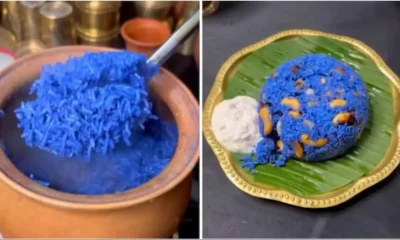
 Food20 hours ago
Food20 hours agoSocial media users stumped after food vlogger makes blue-coloured ghee rice, video viral


